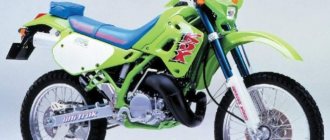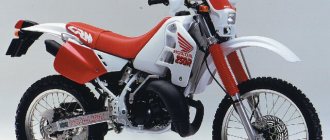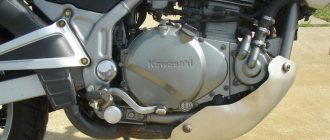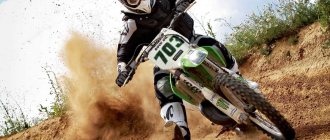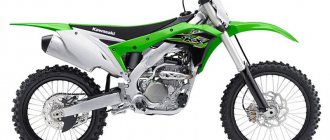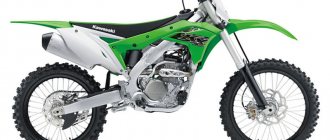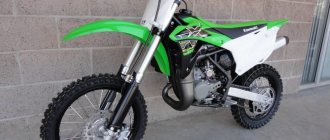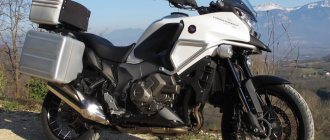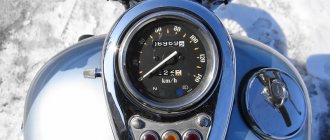| Kawasaki KLX250 (KLX250-A) 1979-1980 | Kawasaki KLX250R (KLX250-D) 1993-1996 | Kawasaki KLX250SR (KLX250-E) 1993-1997 | Kawasaki KLX250 (KLX250-G) 1994-1995 |
| Kawasaki KLX250ES (KLX250-F) 1994-1997 | Kawasaki KLX250 (KLX250-H) 1998-2007 | Kawasaki KLX250 (KLX250-S) 2008-2020 | Kawasaki KLX250S (KLX250-T) 2009-2020 |
Enduro model Kawasaki KLX 250
first appeared in 1979 on the North American market.
This generation of the motorcycle had the factory designation KLX250-A
and was built on the basis of the KX125 2-stroke cross-country model.
The Kawasaki KLX250 model in its usual form was presented in 1993 with two modifications - Kawasaki KLX250R
(off-road version not for DOP) and
Kawasaki KLX250SR
(version for DOP).
Factory designations: KLX250-D
and
KLX250-E
. The model featured a modern look, a steel frame, disc brakes and an inverted fork (on versions for Europe - a regular fork).
Since 1994, new modifications have been added - Kawasaki KLX250
(version for DOP in some European countries) and
Kawasaki KLX250ES
(version for DOP in the Japanese market, has an electric starter and a high-power headlight).
Factory designations: KLX250-G
and
KLX250-F
.
In 1997, all modifications were discontinued, giving way to only one version called Kawasaki KLX250
.
Factory designation - KLX250-H
. This version was universal and suitable for use on public roads. Unlike the previous generation, the new one received a more powerful headlight and minor visual changes; the fuel tank capacity decreased from 8 to 7.2 liters. This generation remained virtually unchanged until 2007, being slightly updated only in 2001 (to meet new environmental standards) and in 2004 moving production to Thailand.
For 2008, the Kawasaki KLX250 receives significant visual updates and a fuel injector instead of a carburetor. The fuel tank capacity has been increased from 7.2 to 7.7 liters. Factory designation - KLX250-S
. This model was only available in the Japanese (Asia) and European markets.
Since 2009, a version of the motorcycle has appeared for the markets of North America and Australia (Oceania), called the Kawasaki KLX250S
.
Factory designation - KLX250-T
.
The model is completely similar to the modification for Japan and Europe (KLX250-S), but has a 250S
on the plastic and a carburetor instead of an injector.
Based on the Kawasaki KLX250 models, a motard was also built - the Kawasaki D-Tracker 250.
2020 was the last year of production of the Kawasaki KLX250, after which it was replaced by a new model - the Kawasaki KLX300.
The main competitors of the Kawasaki KLX250 in the class:
- Honda CRF250L
- Yamaha WR250
- Suzuki 250 SB (complete analogue of Kawasaki D-Tracker 250 / Kawasaki KLX250SF)
Brief history of the model
- 1979 - start of production and sales. First generation.
Model
: Kawasaki KLX250 (North America).
Factory designation:
KLX250-A1.
- 1980 - no significant changes.
Model
: Kawasaki KLX250 (North America).
Factory designation:
KLX250-A2.
- 1993 - restyling of the model. Second generation
. The model is divided into 2 modifications - R and SR.
Model
: Kawasaki KLX250R;
Kawasaki KLX250SR (Europe, Japan). Factory designation:
KLX250-D1; KLX250-E1.
- 1994 - the appearance of the regular KLX250 modification for European countries and the ES modification.
Model
: Kawasaki KLX250;
Kawasaki KLX250R; Kawasaki KLX250SR; Kawasaki KLX250ES (Europe, Japan). Factory designation:
KLX250-G1; KLX250-D2; KLX250-E2; KLX250-F1.
- 1995 - no significant changes.
Model
: Kawasaki KLX250;
Kawasaki KLX250R; Kawasaki KLX250SR; Kawasaki KLX250ES (Europe, Japan). Factory designation:
KLX250-G2; KLX250-D3; KLX250-E3; KLX250-F2.
- 1996 - The regular KLX250 version is no longer offered for Europe.
Model
: Kawasaki KLX250R;
Kawasaki KLX250SR; Kawasaki KLX250ES (Europe, Japan). Factory designation:
KLX250-D4; KLX250-E4; KLX250-F3.
- 1997 - The KLX250R version is no longer offered.
Model
: Kawasaki KLX250SR;
Kawasaki KLX250ES (Japan). Factory designation:
KLX250-E5; KLX250-F4.
- 1998 - restyling of the model. Third generation
.
Model
: Kawasaki KLX250 (Japan).
Factory designation:
KLX250-H1.
- 1999 - no significant changes.
Model
: Kawasaki KLX250 (Japan).
Factory designation:
KLX250-H2.
- 2000 - model not produced.
- 2001 - no significant changes.
Model
: Kawasaki KLX250 (Japan).
Factory designation:
KLX250-H3.
- 2002 - no significant changes.
Model
: Kawasaki KLX250 (Japan).
Factory designation:
KLX250-H4.
- 2003 - no significant changes.
Model
: Kawasaki KLX250 (Japan).
Factory designation:
KLX250-H5.
- 2004 - no significant changes.
Model
: Kawasaki KLX250 (Japan).
Factory designation:
KLX250-H6.
- 2005 - no significant changes.
Model
: Kawasaki KLX250 (Japan).
Factory designation:
KLX250-H7.
- 2006 - no significant changes.
Model
: Kawasaki KLX250 (Japan, North America).
Factory designation:
KLX250-H6F.
- 2007 - no significant changes.
Model
: Kawasaki KLX250 (Japan, North America).
Factory designation:
KLX250-H7F.
- 2008 - restyling of the model. Fourth generation
.
Model
: Kawasaki KLX250 (Japan).
Factory designation:
KLX250-S8F.
- 2009 - appearance of the carburetor modification KLX250S for North America and Australia.
Model
: Kawasaki KLX250;
Kawasaki KLX250S (Japan, Europe, North America). Factory designation:
KLX250-S9F; KLX250-T9F.
- 2010 - no significant changes.
Model
: Kawasaki KLX250;
Kawasaki KLX250S (Japan, Europe, North America). Factory designation:
KLX250-SAF; KLX250-TAF.
- 2011 - no significant changes.
Model
: Kawasaki KLX250;
Kawasaki KLX250S (Japan, Europe, North America). Factory designation:
KLX250-SBF; KLX250-TBF.
- 2012 - no significant changes.
Model
: Kawasaki KLX250;
Kawasaki KLX250S (Japan, Europe, North America). Factory designation:
KLX250-SCF; KLX250-TCF.
- 2013 - no significant changes.
Model
: Kawasaki KLX250;
Kawasaki KLX250S (Japan, Europe, North America). Factory designation:
KLX250-SDF; KLX250-TDF.
- 2014 - no significant changes.
Model
: Kawasaki KLX250;
Kawasaki KLX250S (Japan, Europe, North America). Factory designation:
KLX250-SEF; KLX250-TEF.
- 2015 - no significant changes.
Model
: Kawasaki KLX250 (Japan, Europe).
Factory designation:
KLX250-SFF.
- 2016 - no significant changes.
Model
: Kawasaki KLX250 (Japan, Europe).
Factory designation:
KLX250-SGF.
- 2017 - no significant changes.
Model
: Kawasaki KLX250 (Japan, Europe).
Factory designation:
KLX250-SHF.
- 2018 - no significant changes.
Model
: Kawasaki KLX250;
Kawasaki KLX250S (North America, Australia). Factory designation:
KLX250-SJF; KLX250-TJF.
- 2019 - no significant changes.
Model
: Kawasaki KLX250;
Kawasaki KLX250S (North America, Australia). Factory designation:
KLX250-SKF; KLX250-TKF.
- 2020 is the last year of production.
Model
: Kawasaki KLX250;
Kawasaki KLX250S (North America, Australia). Factory designation:
KLX250-SLF; KLX250-TLF.
Appearance
The Kawasaki KDX 250 looks like a typical enduro. Colors vary, but the color usually appears is green. The light green bike with a blue seat and shock absorbers looks especially impressive. The front light is small and square, like enduro and supermoto.
Spoke wheels make the bike lighter. The front wheel is slightly larger than the rear. The details are clearly visible, which gives the bike a unique effect. However, the frame covers a significant part. There are many similarities between the appearance of the KDX 250 and motocross bikes.
Specifications
Technical characteristics of Kawasaki KLX250 (KLX250-D, E, F, H, S, T):
| Model | Kawasaki KLX250 |
| Motorcycle type | enduro |
| Year of issue | 1979-2020 |
| Frame | steel half-duplex |
| engine's type | 1-cylinder, 4-stroke |
| Working volume | 249 cm³ |
| Bore/Stroke | 72.0 x 61.2 mm |
| Compression ratio | 11.0:1 |
| Cooling | liquid |
| Number of valves per cylinder | DOHC, 4 valves |
| Fuel supply system | Carburetor, 1x Keihin CVK32 – KLX250-D Carburetor, 1x Keihin CVK34 – KLX250-E,F,H,T Injector, 1x – KLX250-S |
| Ignition type | CDI |
| Maximum power | 32.0 hp (23.5 kW) at 8500 rpm – KLX250-D 25.0 hp (18.4 kW) at 8000 rpm – KLX250-E 30.0 hp (22.0 kW) at 8500 rpm – KLX250-F 29.0 hp (21.0 kW) at 9000 rpm – KLX250-H 24.0 hp (18.0 kW) at 9000 rpm – KLX250-S 23.0 hp (17.0 kW) at 8500 rpm – KLX250-T |
| Maximum torque | 26.5 Nm (2.7 kg*m) at 7500 rpm – KLX250-D 22.5 Nm (2.3 kg*m) at 7500 rpm – KLX250-E 25.0 Nm (2.6 kg*m) at 7500 rpm – KLX250-F 25.0 Nm (2.6 kg*m) at 7000 rpm – KLX250-H 21.0 Nm (2.1 kg*m) at 7000 rpm – KLX250-S 21.0 Nm (2.1 kg*m) at 6500 rpm – KLX250-T |
| Transmission | 6-speed |
| type of drive | chain |
| Front tire size | 80/100-21 51M – KLX250-D,E 3.00-21 51P – KLX250-F,H,S,T |
| Rear tire size | 100/100-18 59M – KLX250-D,E 4.60-18 63P – KLX250- F,H,S,T |
| Front brakes | 1 disc, 250 mm, 2-piston caliper |
| Rear brakes | 1 disc, 240 mm, 1-piston caliper |
| Front suspension | Inverted telescopic fork (adjustable), travel - 285 mm - KLX250-D,E,F,H Conventional telescopic fork (adjustable), travel - 290 mm - KLX250-D,H (Europe) 43mm inverted telescopic fork (adjustable), 255mm travel – KLX250-S,T |
| Rear suspension | Pendulum progressive Uni-Trak with mono-shock absorber (adjustable), travel - 280 mm - KLX250-D,E,F,H Pendulum progressive Uni-Trak with mono-shock absorber (adjustable), travel - 230 mm - KLX250-S,T |
| Motorcycle length | 2115 mm – KLX250-D 2135 mm – KLX250-E,F,H 2200 mm – KLX250-S,T |
| Motorcycle width | 910 mm – KLX250-D 870 mm – KLX250-E 885 mm – KLX250-F,H 820 mm – KLX250-S,T |
| Motorcycle height | 1220 mm – KLX250-D 1210 mm – KLX250-E,F,H 1190 mm – KLX250-S 1205 mm – KLX250-T |
| Wheelbase | 1435 mm – KLX250-D,F,H 1440 mm – KLX250-E 1430 mm – KLX250-S,T |
| Seat height | 925 mm – KLX250-D 890 mm – KLX250-E,S,T 885 mm – KLX250-F,H |
| Minimum ground clearance (clearance) | 320 mm – KLX250-D 300 mm – KLX250-E 295 mm – KLX250-F,H 285 mm – KLX250-S,T |
| Acceleration 0-100 km/h (0-60 mph) | 9.17 sec[1] |
| Maximum speed | 121 km/h[2] |
| Gas tank capacity | 8.0 l – KLX250-D,E,F 7.2 l – KLX250-H 7.7 l – KLX250-S,T |
| Motorcycle weight (curb) | 112 kg – KLX250-D 129 kg – KLX250-E 119 kg – KLX250-F 117 kg – KLX250-H 136 kg – KLX250-S 135 kg – KLX250-T |
Peculiarities
The rear suspension is an adjustable pendulum Uni-Trak with a monoshock absorber.
The features of the model include:
- Complete absence of vibrations . Despite the fact that there is only 1 cylinder, there are no problems at normal enduro speeds. If you rev the engine to the red zone, they may appear, but only slightly.
- Electronic instrument panel. Installed only on versions for Europe starting from the fifth generation. Tachometer, speedometer, two trip meters, gear indicator. Additionally, a clock and a fuel indicator. In addition, a standard set of light bulbs: high beam, neutral, turn signals.
Instrument panel - 1999 release.
Instrument panel - 2014 release.
- Standard mirrors . Small size, absolutely flat. Even though it is round, it does not provide a “picture without blind spots”. It is recommended to change immediately.
- Checkpoint . Having a sore characteristic of the brand ( fuzziness ), it is configured in such a way that for most cases one gear is enough. At least for starting off, at least for wheelie.
Since 2004, motorcycle assembly in Japan has been closed. All models of subsequent years come to the market from Thailand.
There are also good opportunities for shooting between rows , the opportunity to upset road inspectors with the presence of registration and rights, and much more.
Reviews
Reviews about Kawasaki KLX250:
Expand Collapse
The purchased motor does not require any special expenses - change the MOTUL 300V10w40 oil once every couple of thousand km, and, if necessary, the oil seals in the fork (this is not difficult). And it will serve you for a long time and give you a lot of positive emotions)))
I owned the KLX for less than a year, bought it in October, sold it in June. All this time I simply didn’t get off it, I drove it almost every day, even in winter. I put on homemade tires with dowels (I got them with the motorcycle, I had to redo the rear one). I lined the chambers with a fire hose so as not to pierce the dowel heads. While I was putting it on I was all pricked))). But it was worth it. It holds the compacted snow in such a way that it is the only way to get on the front and rear wheels! The engine is good, not enough low-end, good at high-end, enough for off-road use. The suspensions are good, they allow you to rush more than 100 on rough roads (with a certain skill), the front is upside down, the motorcycle is very light... If you want to learn how to ride off-road, take the KLX, you will not be disappointed. Over time, you will learn to perform such tricks on it - you won’t believe it yourself. The height of the saddle is small, the legs always reach the ground, it forgives mistakes (sometimes) :)) When I fall, nothing really suffers, at least nothing came off for me.
I took it with zero in 2011. Passed 16k. 95% Asphalt and crushed asphalt (construction bases, warehouses) In the city it’s generally okay - go around the traffic jam, go down the steps, etc. No complaints yet. They write about him that he is strong. My buddy checked it against the fence once, I checked it against the car - everything was ok. Eats 4 liters. The box is a little fuzzy, but this seems to be the case with everyone (forums again). So far it hasn't let me down, in short I'm happy.
After the angry Yamaha VR 450, I decided to take something simpler and more comfortable, I came across a Cavik, rode it and took it with a mileage of 1500 km, drove about 2500, it’s just the thing for a relaxing holiday, and with good tires you can put mud on it!! In general, I'm satisfied. I realized one thing for myself: sports hardenduro is a technique more for competitions than for weekend rides, although it depends on who.
Competitors
In the photo on the left is the Kawasaki KLX 250, on the right is the Yamaha WR250R.
The competitors for the motorcycle are:
- Honda CRF250L.
- Yamaha WR250.
But the Suzuki 250 SB is also noted, but it is more often compared to the Kawasaki D-Tracker 250 motard, which is based on the KLX 250.
What do the owners say?
The motorcycle is reliable, which is clear from the photos and videos. Most owners agree with this. However, someone notes that among all the enduros he has tried, this is not the most reliable.
According to the descriptions of those who have been traveling this way for a long time, the bike usually does not fail, but they still do not advise traveling far from civilization.
Judging by the reviews, it is possible to get good used equipment, but it is important to carefully read the documents. It is advisable to apply all modern methods of checking the condition of the bike to make sure that the machine is well preserved. If the equipment looks good on the outside, this does not mean anything.
Also, one review or another notes that this motorcycle is easy to buy. About 100 thousand Russian rubles – that’s how much such a model costs. The car is praised for its handling and ease of use, but few people called this option the best in the enduro class.
In conclusion, the Kawasaki KDX 250 is the choice for those who want to travel alone and without luggage. The bike is reliable and comfortable, although the best results at the end of the twentieth century were, of course, achieved by Honda. In any case, the machine from Kawasaki is not bad and is still capable of competing with current models.
Comfort
The motorcycle is convenient primarily for those who like to travel to places with not very good roads or without them. A tourist or, especially, a sports-tourist option is not suitable here. And enduro copes well with mud and other difficulties of wild places.
Of course, you won’t be able to take anything with you other than a backpack. But with a competent approach to motorcycle tourism, nothing else is needed. It is important that you have at least two GPS navigators with you, and that the route is thoroughly thought out. Otherwise, the bike is convenient, including maintenance and searching for spare parts.
Main generations of Kawasaki D-Tracker 250:
Kawasaki D-Tracker 250 (1998-2007) - first generation. Produces 30 hp. power, is equipped with a carburetor and has a fuel tank of 8 liters. The model was also sold under the name Suzuki SB250.
Kawasaki D-Tracker X (2008-) - second generation. Known as the KLX250SF in the North American and Australian markets. The model has a more modern appearance, an injector (KLX250SF - carburetor), brake discs of increased diameter, a 7.7 liter fuel tank and a power of 23 hp.
